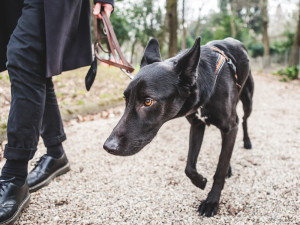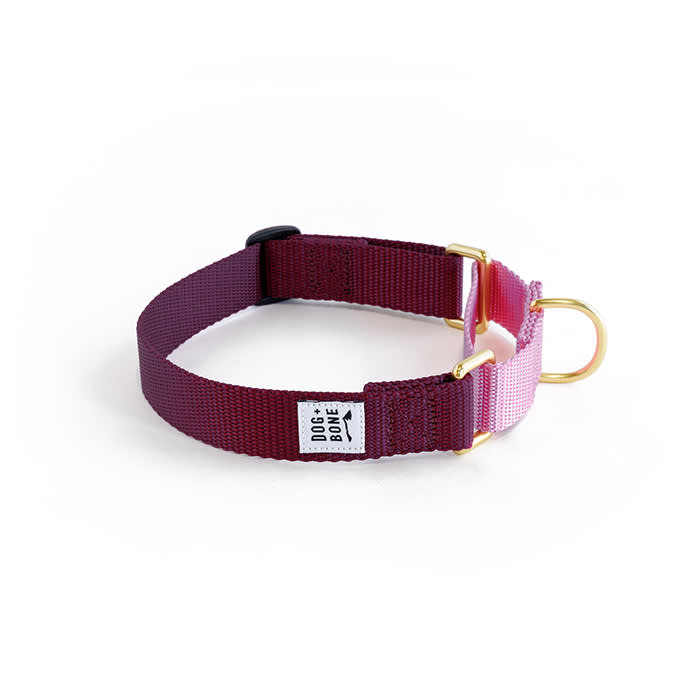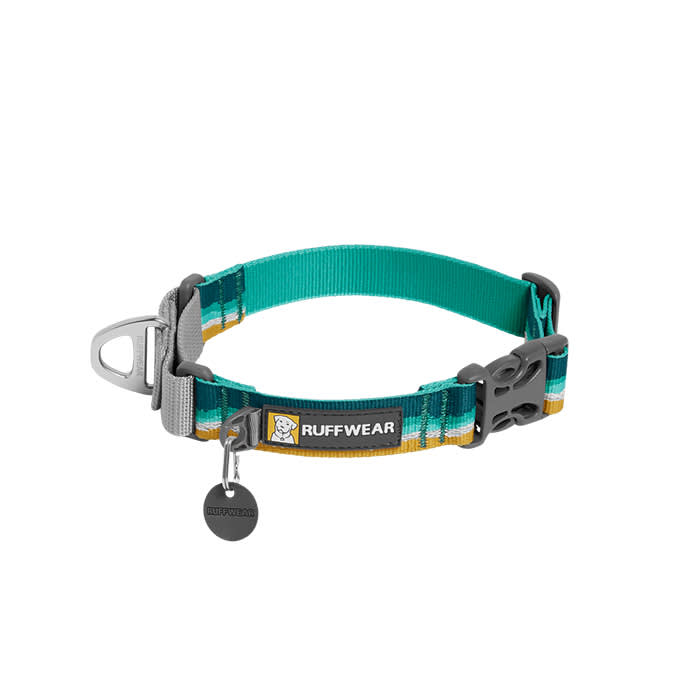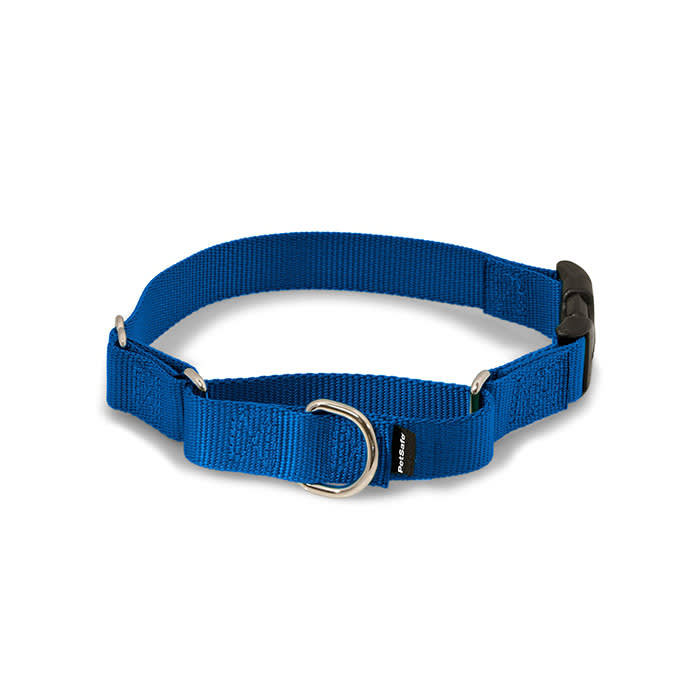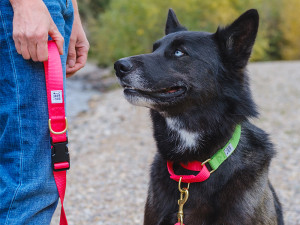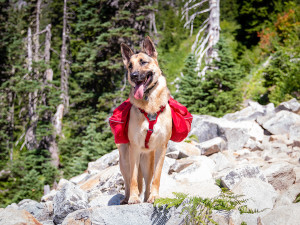Why Your Dog Needs a Martingale Collar
For starters, it prevents escape, works as a training tool, and is recommended by rescue workers.

share article

Your pet wants you to read our newsletter. (Then give them a treat.)
When it comes to buying a collar for your dog, it’s easy to get overwhelmed by the amount of options out there. Do you go with a standard, utilitarian nylon collar with a buckle? One of those elaborate, beaded Susan Alexandra collarsopens in a new tab that could be mistaken for currently trending human accessoriesopens in a new tab? Did you know that even Gucci makes collarsopens in a new tab now? Maybe you forgo a collar entirely in favor of a harnessopens in a new tab. But then, the spiral begins again: What kind of harness? Back clip? Front clip? Head haltie? The sheer number of possible canine restraints is dizzying.
The answer, of course, depends on your dog and their specific needs. But for many dog trainers, walkers, and rescue professionals, one collar has become an indispensable tool for ensuring the safety of dogs who might slip out of a regular collar: the martingale.
The martingale collar, also known as a “limited-slip collar” or a “Greyhound collar” is a collar with two loops. The first wraps around about three-quarters of the width of the dog’s neck, and the two ends of it are connected by a “control loop,” which can be made of fabric or chain and is where the leash is attached. When the collar is correctly fitted, the design of the martingale allows one to tighten the collar without choking the dog. Below, everything you need to know to determine if a martingale collar is right for your dog and how to adjust the fit to use it correctly.
Where Did Martingale Collars Come From?
It’s unclear when, exactly, the martingale collar was first invented, but experts agree that it was first used primarily for Sighthounds like Greyhounds, Whippets, and Salukis, who have long, thick necks and narrow heads that regular collars can easily slip over.
The term martingale likely comes from a piece of horse tack known as a martingale, which is also known as a “tiedown” or “headcheck,” and is a strap that prevents the horse’s head from whipping so far back that it risks hitting the rider.
How Are Martingale Collars Used?
Beyond their popularity with Sighthound guardians, martingales have become a favorite tool among those working in dog rescue as well, because they prevent skittish dogs from slipping out of collars without risk of choking and traumatizing them. (The martingale, to be clear, is not a choke collar — when correctly sized, it tightens just to the width of your dog’s neck, but not more than that.)
Melissa Giordano, the adoption coordinator for The Sato Projectopens in a new tab, which rescues, rehabilitates, and rehomes stray dogs from Puerto Rico, says that she’s used martingale collars for almost 15 years, and that they are an essential tool for keeping her organization’s rescues safe. “We fly all of our dogs over from Puerto Rico, so they come off the plane — it’s loud, it’s a new environment, and it’s scary. Sometimes their flight instincts are strong, and they just want to run,” she explained. “So we have to have something that they can’t slip out of, that’s going to be secure but also doesn’t risk injuring them like a traditional choke collar.”
Robert Haussmannopens in a new tab, a certified professional dog trainer, co-founder of Dogboy NYCopens in a new tab, and The Wildestopens in a new tab member, recommends his clients use martingales in conjunction with other collars or harnesses as a safety precaution. “If I talk to walking companies, I usually encourage them to have some martingale collars as a backup for whatever device their clients are using,” he says. “So if a client is using a no-pull harness, or a head collar, or a traditional harness that closes between the shoulder blades, the martingale can be used as well, just in case there’s an equipment failure.”
Haussmann uses a martingale with his own dog, who is “shaped like a whippet,” and says it’s a “fantastic” everyday collar for dogs who are already calm and responsive on a leash. Still, he warns against leaning on it too heavily as a training device. Owners of dogs who are easily excitable, or who pull a lot, might be inclined to use the martingale’s tightening ability as a punishment for a dog who pulls. But this punishment, Haussmann warns, can exacerbate a dog’s nervousness and behavioral issues, and add more stress to an already stressful situation.
“There is no tool that makes up for the relationship between you and your dog, and the work and effort you’re putting into training that dog,” he says. “A lot of times, people use devices like that to suppress behaviors instead of teaching their dogs appropriate behaviors.”
What to Know Before Getting a Martingale Collar
The most important thing to keep in mind when getting any collar, but especially a martingale, is fit. Melissa Giordano says that whichever type of collar you get your dog, a good rule of thumb is that you want to be able to fit two fingers underneath it when the dog is wearing it. “You want it to be snug but comfortable, so the dog has room to breathe.”
Martingales come in a variety of sizes, shapes, and patterns (for sighthounds, for example, there are thicker collars that help distribute pressure around their long necks) so finding the right one for your dog may take some measuring and shopping around online. Girodano also says that, for safety reasons, she personally prefers a martingale with a quick-release buckle. That way, she says, if the dog’s collar gets caught on something and they start choking, it’s easy to free them without having to find scissors to cut the collar off.
Once you get the collar, make sure to give your dog time to get comfortable with it before you take them out on a walk. Haussmann recommends letting your dog smell the collar, clicking the buckle so they get used to the sound, and having them wear it for brief periods around your home so they can get used to how it feels.
And remember, Haussmann notes, to pair any collar or harness with regular training: “Once your dog knows how to walk well on a leash and is doing a great job, then by all means, [a martingale] can be your full-time collar.”
The Best Martingale Collars

Madeleine Aggeler
Madeleine Aggeler is a freelance journalist and copywriter in Washington, D.C. Previously, she was a writer at New York magazine’s The Cut. She lives with her dog, Cleo, who works primarily as a foot warmer.
Related articles
![French bulldog smiling with blue harness]() opens in a new tab
opens in a new tabStrap in: Dog Collars vs. Harnesses
Style and safety don’t have to be mutually exclusive (phew).
![Dog wearing a collar and leash by the company Dog + Bone]() opens in a new tab
opens in a new tabBehind the Brand: Dog + Bone
A company set out to prove that not all collars are created equal.
![A German Shepherd dog wearing a red hiking backpack on a rocky trail.]() opens in a new tab
opens in a new tab11 Must-Have Items to Take on a Hike with Your Pup
When heading out on a hike with your dog, the items you pack will vary from trip to trip and dog to dog, but there are a few things that every hiker should have packed. Here are the top ten hiking essentials for pet parents. Don’t forget these hiking essentials.
